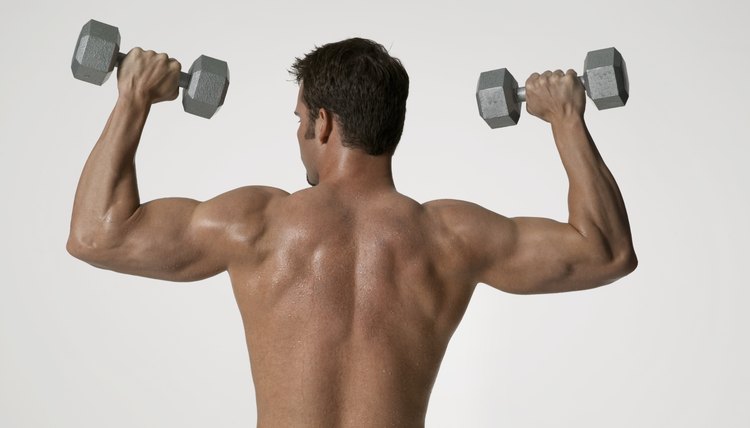How the Muscular System Responds to Exercise

Your muscles respond to exercise in a number of ways, both during and after your workouts, improving your strength, speed, power and endurance. Depending on what type of exercise you perform, your body calls on its aerobic or anaerobic energy system to help your muscles do their required functions.
Contractions
Muscles contract during exercise, creating eccentric, eccentric or isometric contractions to perform work. When you raise a dumbbell during a biceps curl, your muscles contract, creating a concentric contraction. When you lower the weight, your muscles lengthen, creating an eccentric contraction. If your muscle resists force without moving, such as pushing against a wall or holding a weight steady, your muscles create isometric contractions.
Fuel Use
A chemical called adenosine triphosphate helps make muscle contractions. After a few repetitions, you deplete the stores of ATP in your muscles and must create more. Initially, you burn glycogen to replace these stores. The longer you work, the more fat you burn. During short, high-intensity exercise, such as sprint training or a tennis match, your body use mostly glycogen. If you exercise for long periods without a break, such as when you jog or use a cardio machine, your muscles burn more fat. When you exercise, your body produces lactic acid, which inhibits muscle contractions. The longer you take between a point or play, the more lactic acid leaves your muscle -- but not all of it. The longer you exercise, the more lactic acid you have in your muscles, which can eventually lead to cramping and muscle fatigue.
Muscle Fiber Use
Your muscles contain fibers that help them contract. To perform powerful movements, your muscles call on your slow-twitch muscle fibers. To create quick, high-intensity movements, your muscles use more high-twitch muscle fibers. While you can’t increase the number of either type of muscle fibers, specific training helps increase their size. This is why competitive athletes perform strength training and aerobic exercise during the off season, and explosive, anaerobic training during the preseason and during their season.
Hypertrophy
Weight lifting and other resistance exercise does not build muscle; it damages it. As your body recovers from resistance and repairs tears to your muscle fibers, your muscles grow larger. Most of this process takes place within 48 hours of your workouts, which is why bodybuilders leave at least 24 hours between workouts, or perform an upper-body workout in the morning and a lower-body workout during the afternoon.
Stretching
When you stretch your muscles and hold them, this helps improve flexibility for later workouts. This process also temporarily desensitizes muscles, causing a decrease in power and vertical leap for up to 20 minutes. This is why you should save static stretching until after exercise.
Heart and Lungs
Your heart and lungs are part of the muscular system and respond to exercise by increasing their capacity to perform work and their ability to perform work longer, known as stamina or endurance. Exercising harder increases capacity, while working out longer increases endurance.
References
Writer Bio
Sam Ashe-Edmunds has been writing and lecturing for decades. He has worked in the corporate and nonprofit arenas as a C-Suite executive, serving on several nonprofit boards. He is an internationally traveled sport science writer and lecturer. He has been published in print publications such as Entrepreneur, Tennis, SI for Kids, Chicago Tribune, Sacramento Bee, and on websites such Smart-Healthy-Living.net, SmartyCents and Youthletic. Edmunds has a bachelor's degree in journalism.
